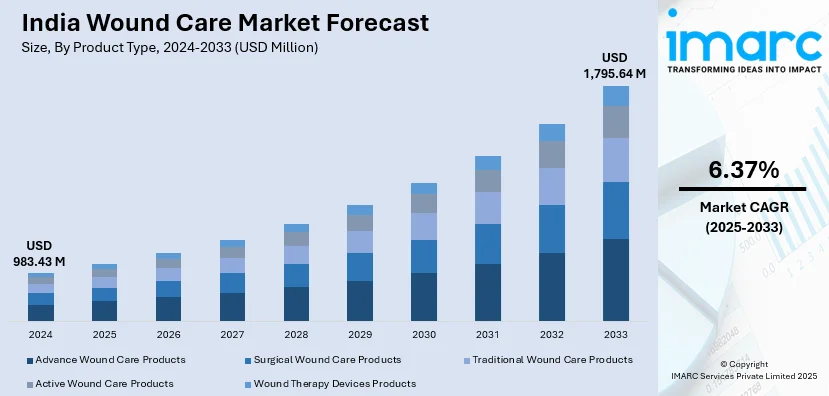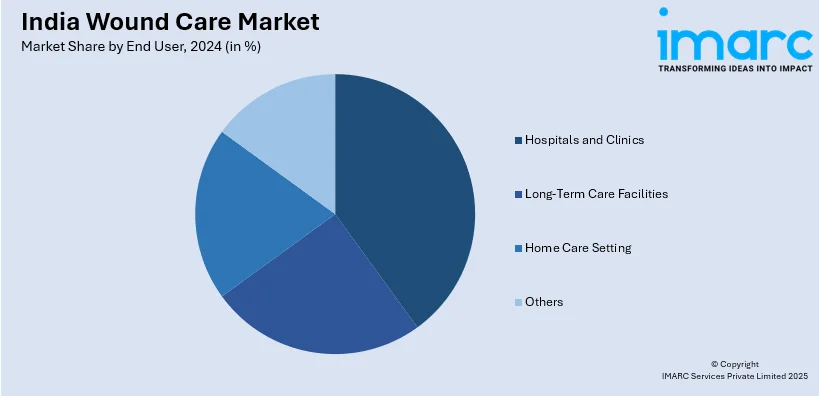
India Wound Care Market Size, Share, Trends and Forecast by Product Type, Wound Type, End User, and Region, 2025-2033
India Wound Care Market Overview:
The India wound care market size reached USD 983.43 Million in 2024. Looking forward, IMARC Group expects the market to reach USD 1,795.64 Million by 2033, exhibiting a growth rate (CAGR) of 6.37% during 2025-2033. The market is propelling with the accelerating chronic wounds, improving healthcare access, and enhanced demand for advanced and home-based treatments. Biodegradable and antimicrobial dressing innovation, coupled with government initiatives, is propelling market growth in hospitals, clinics, and home healthcare.
|
Report Attribute
|
Key Statistics
|
|---|---|
|
Base Year
|
2024 |
|
Forecast Years
|
2025-2033
|
|
Historical Years
|
2019-2024
|
| Market Size in 2024 | USD 983.43 Million |
| Market Forecast in 2033 | USD 1,795.64 Million |
| Market Growth Rate (2025-2033) | 6.37% |
India Wound Care Market Trends:
Growing Demand for Advanced Wound Care Products
India's market for wound care is moving from conventional bandaging and gauze to wound care products with higher technology content that provide quick healing, lesser infection risk, and greater comfort to the patient. For instance, in February 2024, an ultra-modern wound dressing which arrests uncontrollable bleeding within a few minutes attracted interest in India with the Indian Army joining 40 nations which accepted it as an emergency trauma aid. Moreover, products, such as hydrocolloid, hydrogel, and alginate dressings are on the rise based on their improved moisture retention ability and better healing properties. Further, bioactive wound care products that have growth factors, collagen, and silver-based antimicrobial drugs are increasingly popular, particularly for the treatment of chronic wounds, like diabetic foot ulcers, pressure sores, and venous leg ulcers. The growing incidence of diabetes and lifestyle-related disorders is the key driver for this trend. Healthcare accessibility enhancement drives initiated in the government sector and investments made by the private sector in advanced wound care solutions are supporting the adoption even further. Additionally, healthcare professionals are promoting evidence-based wound care treatment, which is driving the movement toward more effective and technology-focused wound care interventions in hospitals, clinics, and home healthcare facilities.

To get more information of this market, Request Sample
Rise in Home-Based Wound Care
Demand for home wound care products is growing in India, fueled by the growth of telemedicine, home healthcare companies, and patient desire for self-care. Most patients, particularly the elderly and those with long-term diseases, would rather get their wounds treated at home than go to clinics or hospitals repeatedly. This trend has fueled demand for simple-to-use dressings for wounds, antimicrobial bandages, and high-performance self-adhesive patches. Foam dressings, silicone dressings, and hydrogel solutions are being engineered to enable minimal professional intervention at home for wound care. In addition, digital health technologies, like remote wound monitoring systems and mobile health applications are enabling this shift by enabling healthcare professionals to remotely guide patients. Increasing awareness and availability of these solutions will drive the home-based wound care segment to grow significantly, especially in urban and semi-urban locales where home healthcare is growing fast.
Focus on Biodegradable and Sustainable Wound Care Solutions
Sustainability is also becoming an important aspect of India wound care market, and this is spurring on the innovation and adoption of biodegradable and environmentally friendly wound care products. Conventional wound dressings create a lot of medical waste, and this is driving the healthcare community and consumers to alternative sustainable solutions. Developments in biodegradable wound dressings from natural polymers like chitosan, alginate, and collagen are popular for their biocompatibility and lower environmental footprint. According to the sources, in February 2024, Scientists at the Institute of Advanced Study in Science and Technology (IASST) have developed a biodegradable wound dressing made from banana fibres, chitosan, and plant extracts, providing an affordable, eco-friendly solution for enhanced wound care. Moreover, herbal and plant-based wound healing products, such as honey dressing and Ayurvedic preparations are gaining traction since they fit well with India's conventional medicine practices. Support from these regulatory environment for greener healthcare products and growing consumer knowledge about environmental sustainability are also encouraging the trend forward. Hospitals and healthcare centers are also embracing environmentally friendly practices by incorporating sustainable wound care products in their treatment practices. As sustainability takes root, the biodegradable and nature-based wound care market will grow very quickly.
India Wound Care Market Segmentation:
IMARC Group provides an analysis of the key trends in each segment of the market, along with forecasts at the region level for 2025-2033. Our report has categorized the market based on product type, wound type, and end user.
Product Type Insights:
- Advance Wound Care Products
- Foam Dressing
- Hydrocolloid Dressing
- Film Dressing
- Alginate Dressing
- Hydrogel Dressing
- Collagen Dressing
- Others
- Surgical Wound Care Products
- Sutures
- Staplers
- Tissue Adhesive, Sealants and Hemostats
- Anti-effective Dressing
- Traditional Wound Care Products
- Medical Tapes
- Cleansing Agent
- Active Wound Care Products
- Biological Skin Substitutes
- Topical Agents
- Wound Therapy Devices Products
- Negative Pressure Wound Therapy
- Oxygen and Hyperbaric Oxygen Equipment
- Electric Stimulation Devices
- Pressure Relief Devices
- Wound Assessment and Monitoring Devices
- Others
The report has provided a detailed breakup and analysis of the market based on the product type. This includes advance wound care products (foam dressing, hydrocolloid dressing, film dressing, alginate dressing, hydrogel dressing, collagen dressing, and others), surgical wound care products (sutures, staplers, tissue adhesive, sealants and hemostats, and anti-infective dressing), traditional wound care products (medical tapes and cleansing agents), active wound care products (biological skin substitutes and topical agents), and wound therapy devices products (negative pressure wound therapy, oxygen and hyperbaric oxygen equipment, electric stimulation devices, pressure relief devices, wound assessment and monitoring devices, and others).
Wound Type Insights:
- Chronic Wounds
- Diabetics Ulcers
- Pressure Ulcers
- Venous Leg Ulcers
- Others
- Acute Wounds
- Surgical Traumatic Wounds
- Burns
A detailed breakup and analysis of the market based on the wound type have also been provided in the report. This includes chronic wounds (diabetic ulcers, pressure ulcers, venous leg ulcers, and others), and acute wounds (surgical traumatic wounds and burns).
End User Insights:

- Hospitals and Clinics
- Long-Term Care Facilities
- Home Care Setting
- Others
The report has provided a detailed breakup and analysis of the market based on the end user. This includes hospitals and clinics, long-term care facilities, home care setting, and others.
Regional Insights:
- North India
- South India
- East India
- West India
The report has also provided a comprehensive analysis of all the major regional markets, which include North, South, East, and West India.
Competitive Landscape:
The market research report has also provided a comprehensive analysis of the competitive landscape. Competitive analysis such as market structure, key player positioning, top winning strategies, competitive dashboard, and company evaluation quadrant has been covered in the report. Also, detailed profiles of all major companies have been provided.
India Wound Care Market News:
- In September 2024, HCAH has introduced the "WOW Nurses" initiative in partnership with Aroa Biosurgery to improve wound care in India. The program targets prevention and management of bedsores, education of nurses in the care of advanced wounds, and patient recovery outcomes through innovative solutions for soft tissue regeneration.
- In August 2024, Indian scientists at the Institute of Nano Science and Technology (INST), Mohali, have created a self-sustaining dressing aid with antibacterial action to heal chronic wounds such as diabetic foot ulcers. The dressing employs electroactive hydrogel microparticles and a PVDF membrane to speed up healing by electrical stimulation and management of moisture, lowering the risk of infection and hospitalization.
India Wound Care Market Report Coverage:
| Report Features | Details |
|---|---|
| Base Year of the Analysis | 2024 |
| Historical Period | 2019-2024 |
| Forecast Period | 2025-2033 |
| Units | Million USD |
| Scope of the Report |
Exploration of Historical Trends and Market Outlook, Industry Catalysts and Challenges, Segment-Wise Historical and Future Market Assessment:
|
| Product Types Covered |
|
| Wound Types Covered |
|
| End Users Covered | Hospitals and Clinics, Long-Term Care Facilities, Home Care Setting, Others |
| Regions Covered | North India, South India, East India, West India |
| Customization Scope | 10% Free Customization |
| Post-Sale Analyst Support | 10-12 Weeks |
| Delivery Format | PDF and Excel through Email (We can also provide the editable version of the report in PPT/Word format on special request) |
Key Benefits for Stakeholders:
- IMARC’s industry report offers a comprehensive quantitative analysis of various market segments, historical and current market trends, market forecasts, and dynamics of the India wound care market from 2019-2033.
- The research report provides the latest information on the market drivers, challenges, and opportunities in the India wound care market.
- Porter's five forces analysis assist stakeholders in assessing the impact of new entrants, competitive rivalry, supplier power, buyer power, and the threat of substitution. It helps stakeholders to analyze the level of competition within the India wound care industry and its attractiveness.
- Competitive landscape allows stakeholders to understand their competitive environment and provides an insight into the current positions of key players in the market.
Key Questions Answered in This Report
The India wound care market size reached USD 983.43 Million in 2024.
The India wound care market is expected to reach USD 1,795.64 Million by 2033, exhibiting a CAGR of 6.37% during 2025-2033.
Market growth is driven by the rising prevalence of chronic wounds, diabetic ulcers, and surgical wounds. Increasing awareness about advanced wound care products, along with improvements in healthcare infrastructure and government initiatives to enhance patient care, are also contributing. Additionally, the expanding geriatric population and growing cases of lifestyle-related diseases like diabetes are fueling demand. Innovation in wound care technologies and increasing adoption of specialized products in hospitals and clinics further support the market’s growth.
Need more help?
- Speak to our experienced analysts for insights on the current market scenarios.
- Include additional segments and countries to customize the report as per your requirement.
- Gain an unparalleled competitive advantage in your domain by understanding how to utilize the report and positively impacting your operations and revenue.
- For further assistance, please connect with our analysts.
 Request Customization
Request Customization
 Speak to an Analyst
Speak to an Analyst
 Request Brochure
Request Brochure
 Inquire Before Buying
Inquire Before Buying




.webp)




.webp)












